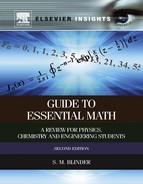To the Reader
Let me first tell you how the idea for this book came about. Many years ago, when I was a young assistant professor, I enthusiastically began my college teaching in a Junior-level course that was supposed to cover quantum mechanics. I was eager to share my recently-acquired insights into the intricacies of this very profound and fundamental subject which seeks to explain the structure and behavior of matter and energy. About five minutes into my first lecture, a student raised his hand and asked, “Sir, what is that funny curly thing?” The object in question was
![]()
Also, within the first week, I encountered the following very handy—but unfortunately wrong—algebraic reductions:
![]()
Thus began my introduction to “Real Life” in college science courses!
All of you here—in these intermediate-level physics, chemistry, or engineering course—are obviously bright and motivated. You got through your Freshman and Sophomore years with flying colors—or at least reasonable enough success to be still here. But maybe you had a little too much fun during your early college years—which is certainly an inalienable privilege of youth! Those math courses, in particular, were often a bit on the dull side. Oh, you got through OK, maybe even with As or Bs. But somehow their content never became part of your innermost consciousness. Now you find yourself in a Junior, Senior, or Graduate level science course, with prerequisites of three or four terms of calculus. And your Prof assumes you have really mastered the stuff. On top of everything, the nice xs, ys, and zs of your math courses have become ![]() s,
s, ![]() s,
s, ![]() s and other unfriendly-looking beasts.
s and other unfriendly-looking beasts.
This is where I have come to rescue you! You don’t necessarily have to go back to your prerequisite math courses. You already have, on some subconscious level, all the mathematical skills you need! So here is your handy little Rescue Manual. You can read just the parts of this book you think you need. And there are no homework assignments. Instead, we want to help you do the problems you already have in your science courses. You should, of course, work through and understand steps we have omitted in presenting important results. In many instances, it is easier to carry out a multistep derivation in your own way rather than to try and follow someone else’s sequence of manipulations.
SMB
Ann Arbor
June 2006
